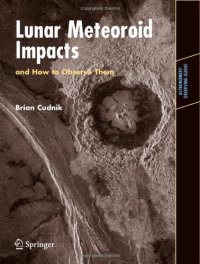
Ebook: Lunar Meteoroid Impacts and How to Observe Them
Author: Brian Cudnik (auth.)
- Genre: Physics // Astronomy
- Tags: Astronomy Observations and Techniques, Popular Science in Astronomy
- Series: Astronomers' Observing Guides
- Year: 2009
- Publisher: Springer-Verlag New York
- Edition: 1
- Language: English
- pdf
We all know that the pock marked face of the Moon looks the way it does because it was hit by meteors. But not many people know that this is still happening today. While the era of major impacts is over, lunar meteorites still cause flashes and puffs of gas, vaporized rock, and dust that we can observe.
The Moon itself has a fascinating history. It is now thought to have been formed after a Mars-sized object collided with Earth and stripped off a portion of its mass. This debris took shape within a few hundred years and was originally much closer to our planet. The craters on its surface were largely formed by intense meteorite and asteroid bombardment between 4.6 billion and 3.8 billion years ago.
In this comprehensive book, Brian Cudnik, one of the first people to observe a meteorite impact on the Moon in real time, shows how both amateur and practical astronomers can look for these ‘lunar transient phenomena,’ or LTPs. He explains in detail the processes that formed the craters and impact marks we see on the Moon and elsewhere in the Solar System, and he details the events leading up to our recognition that the Moon is not a ‘dead’ world in terms of meteors but is still being hit by space debris.
Meteors and asteroids have melted the Moon’s crust, forming the lunar magma ocean, and caused enormous impact craters that, like an old warrior’s battle scars, give us a visual history of the planet. As amateur astronomy becomes ever more sophisticated, this book interprets the Moon’s scars and acts as a guide to observing our nearest planetary neighbor, showing how amateurs can support and even compete with the professionals in this field.
The face of the Moon we see today has been substantially etched by the effects of meteor impacts. Craters on the Moon are the result of ancient impacts with large meteorites - or small asteroid-like bodies - which produced both primary craters (where the meteorites hit) and secondary craters (where material hurled high above the surface crashed back down). Even some of the vast lunar "seas" - actually basalt plains from ancient volcanic eruptions - may have been the result of impacts that triggered lava outflows. The era of major impacts on the Moon may have passed, but lunar meteorites may well be the cause of what are known as Lunar Transient Phonomena ("LTP" or sometimes "TLP") flashes and puffs of gas or vaporized rock or dust that are observed on the Moon's surface. This book looks at the way the Moon has been shaped by meteorites, proposes lunar meteorites as the most likely cause of most LTPs and describes in practical detail how amateur astronomers can observe impacts on the Moon, past and current.